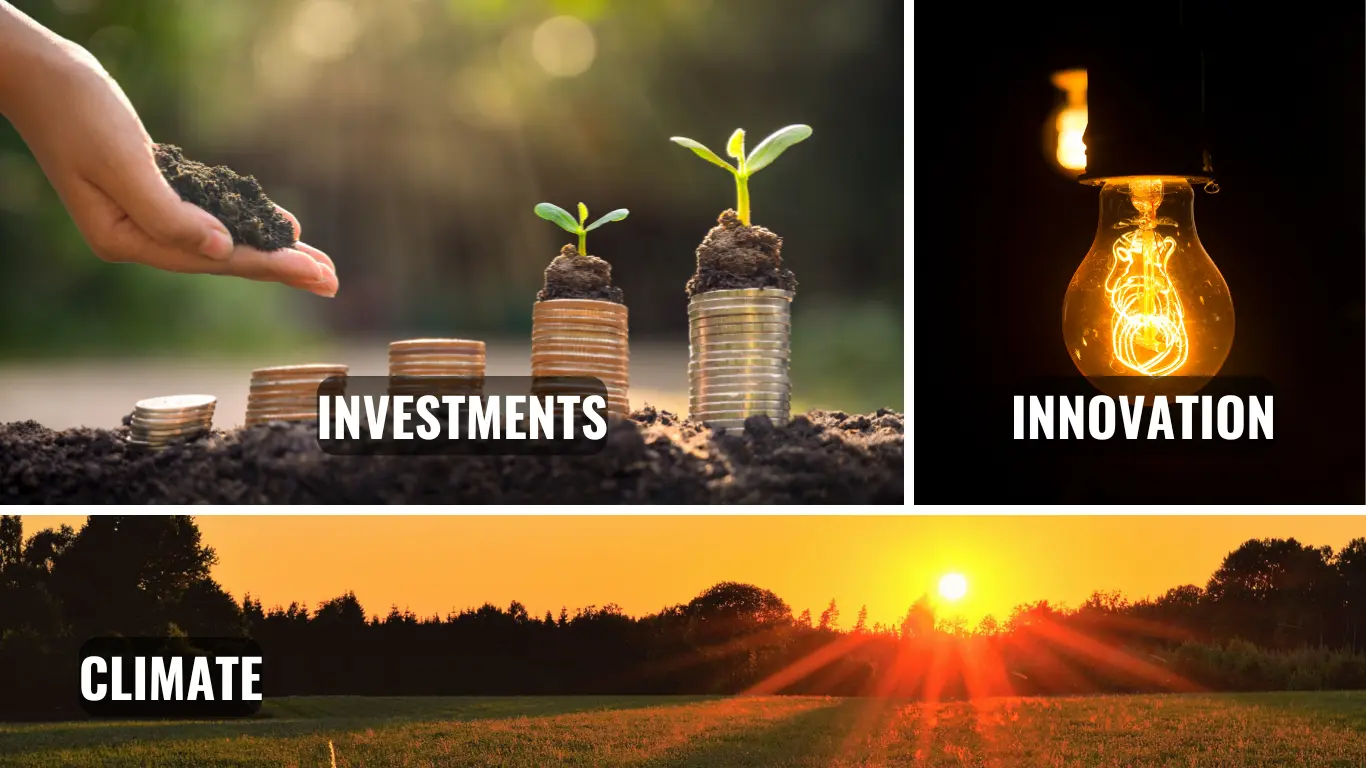Introduction
Climate Change is a global problem. Many nations & organizations have met at various conferences & summits to tackle the issue & set achievable goals. Thus, since the 1990s, the world has witnessed conferences & treaties like The Kyoto Protocol (1997), Paris Agreement(2015), COP’26, 27, & 28, UNFCCC, and others. In the wake of global discourses, nations have set up policies, missions, and milestones to achieve the target of reducing carbon emissions.
Thus, they promise to achieve Net-Zero emissions by 2030, 2050, or 2070, bringing change & innovation in many climate sectors. As the work to solve climate gains momentum, the focus has shifted to climate finance & investment. The global challenge to meet international requirements pushes demands for innovation and transformation. This has triggered an opening for investment in the hottest climate technology. But how is it to be achieved?
Climate is Changing

Earth’s climate has been changing since billions of years ago. The change occurs gradually spanning across centuries, millenniums, and eons of time. However, recently, human activities like the burning of fossil fuels, deforestation, and industrial manufacturing have accelerated the rate of change. Thus, Earth’s climate is transforming at a heightened speed, growing much hotter in a short span of time. According to a report by IPCC, in the past 100 years, since the Industrial Revolution, Earth’s global temperature has gone up by 1.2°C. Comparatively, the temperature did not increase so rapidly in the pre-industrial era as climate change chiefly occurred due to natural causes like volcanic eruptions & solar radiation. Now, as human activities continue to compound, they affect the climate severely, pushing it to the tipping point where there could be no recovery.
Net Zero & SDGs
Amongst other things, the Industrial Revolution greatly increased the quality of life and standard of living across the rising capitalist economies. So, the income band expanded bringing much comfort and luxury in people’s life. However, it also resulted in high energy consumption and the release of greenhouse gasses into the environment. Since the 19th century, carbon emissions have been compounded by trillions of tonnes.
The current strategy to achieve Net Zero emissions and curb the rate of emissions includes switching to renewables and adopting modern technology. This is necessary because there are still parts of the world where the standard of living is poor, demanding urgent energy and manufacturing. However, if this demand for energy is provided by current technology in use, then it will trigger a climate disaster. As climate change grows worse and surface temperature increases, there will be demand for more air conditioning, transport, and housing. This will result in an even higher rate of emissions, leading to a climate disaster. Thus, the challenge to achieve net zero is to cut down emissions without squandering development goals (SDGs). This is possible only with technological innovation, policies, and investments.
Climate Technology & Investments
As the threat of climate change grows worse, organizations, nations, and industries push for the development of clean and green technologies. This demands urgent requirements of modern technologies that meet development needs without emitting high carbons or harming the environment. Thus, there is a growing trend and market for the wide adoption of climate-friendly products and services, as a significant portion of the population is open to making changes to prevent climate disasters.
Thus, scientists, inventors, entrepreneurs, startups, innovators, corporations, think tanks, governments, SMEs, and all entities building modern climate-friendly technology hold the key to solving the deadlock of climate change and sustainable development. However, a transition on a global level to climate-friendly technology and renewable energy is not possible without policy support, public demand, and large-scale investments to fund the growth. In short, climate technology can solve climate change, but it needs a whole functioning ecosystem to induce a paradigm shift and spark a Climate Revolution (A successor to the Industrial Revolution).
Investing in climate technology holds the potential to trigger this paradigm shift, but it cannot follow a traditional investment cycle to boost technological innovation as the challenge is quite different. Since the development of climate technology holds disruptive potential, it demands a lot of grants, funds, and investments at the early stage of research and prototype. However, the sums allocated to the research stage (~₹1 crore) is quite low compared to the high investment size of ₹80-100 crore at the early to late growth stage. It implies that climate tech startups require great capital to boost their growth.
Alternatively, it shows that there is scope for angel investments in budding climate tech startups as climate tech would prove to be the most disruptive technology in the upcoming years, guaranteeing alpha returns.
Conclusion
The 21st-century climate crisis, SDGs, and demand for clean energy open up investment and funding opportunities in climate tech startups. There is a huge demand for capital in order to build disruptive technology that’ll solve climate change without failing development goals. However, it will be difficult to kick-start the climate landscape without altering the traditional investment pattern, as the challenge to build clean tech differs from other industries. Startups and inventors demand large capital at research stages, opening up angel investment opportunities and guaranteeing large returns. It also holds the potential to solve climate change & become the industry leader that scales the solution at global level.






